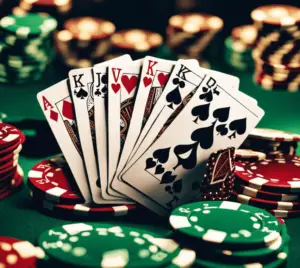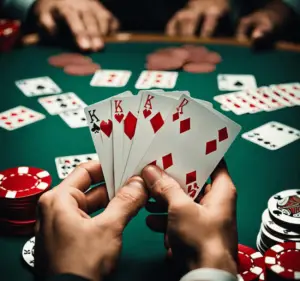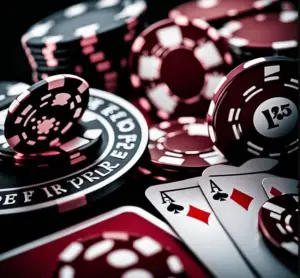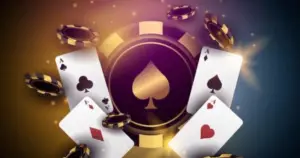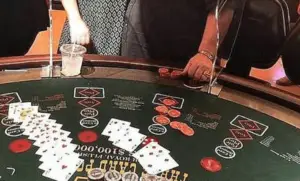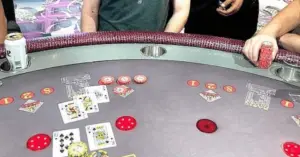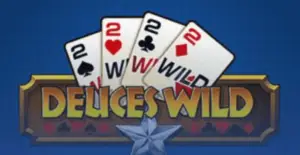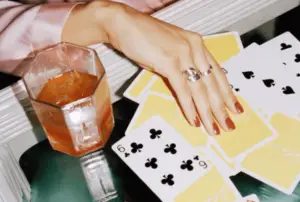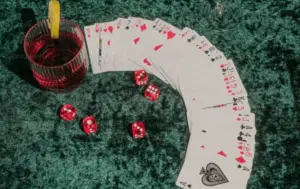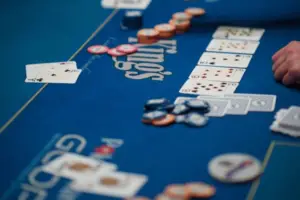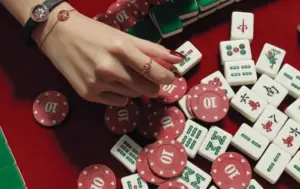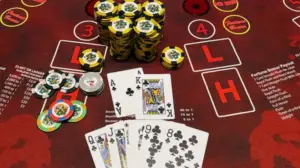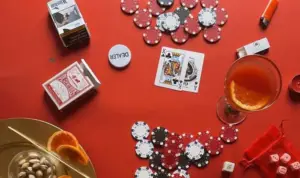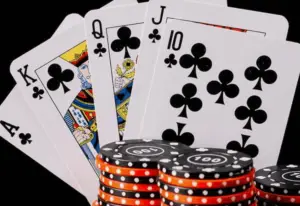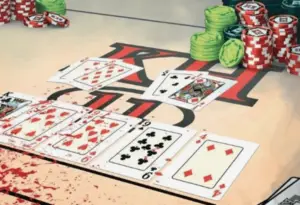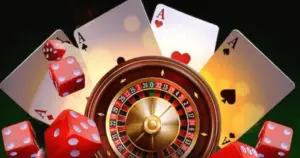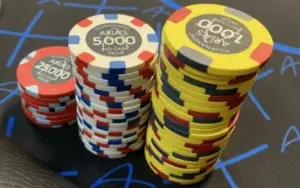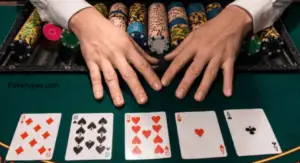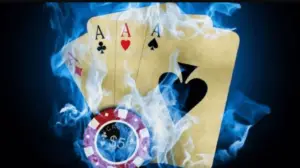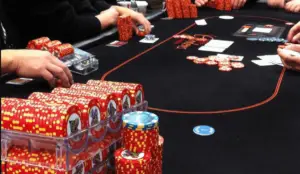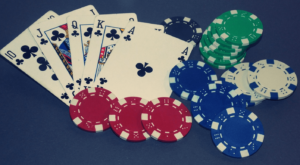Baduci Poker is a unique card game that blends two exciting poker variants: Badugi and 2-7 Triple Draw. This lowball game, also known as Badeucy or Badeucey, has its roots in Asia, particularly Korea and China. Players aim to make the best four-card Badugi hand and the best five-card 2-7 Triple Draw hand simultaneously.
Baduci gained popularity among high-stakes players in Las Vegas due to its mix of luck and strategy. The game’s online presence has grown since 2008 when PokerStars first introduced it.
Today, Baduci is featured on various online poker platforms and in live mixed cash games. Its challenging nature and unique gameplay have made it a favorite among skilled players looking for a fresh twist on traditional poker.
Basic Rules and Gameplay of Baduci
1. Deck and Player Setup
Baduci Poker uses a standard 52-card deck. It’s a game that mixes two types of poker Badugi and 2-7 Triple Draw. You’ll need at least two players, but it’s best with 4-6 folks around the table.
To get started, everyone antes up(puts in a small bet). Then, the dealer button moves clockwise after each hand.
The player to the left of the button is the small blind, and the next player is the big blind. These are forced bets to kick things off. Here’s how a typical setup might look:
- Number of players: 6
- Ante: $1
- Small blind: $2
- Big blind: $4
Once the blinds are in, each player gets five cards face down. That’s right, five cards, not four like in regular Badugi. You’ll see why in a bit!
2. Betting Structure and Blinds
Baduciusually uses a fixed-limit betting structure. This means there’s a cap on how much you can bet or raise. Let’s break it down:
Small bet rounds: The first two betting rounds use the small bet. In our example, that’s $4.
Big bet rounds: The last two rounds double the bet. So, $8 in our game.
The betting action starts with the player to the left of the big blind. They can:
- Fold: Give up their hand
- Call: Match the big blind
- Raise: Increase the bet (usually to $8 in our example)
Play continues clockwise until everyone has acted and all bets are equal.
Pro tip: Position is key in Baduci. The later you act, the more info you have!
3. Dealing and Drawing Rounds
Now comes the fun part –drawing! Baduci has three drawing rounds. Here’s how they work:
After the first betting round, players can discard and draw new cards.
Starting left of the dealer, each player says how many cards they want to swap.
You can keep all your cards (called “standing pat“) or trade up to all five!
After each draw, there’s another betting round. The pattern goes like this:
- Deal 5 cards
- Bet
- Draw
- Bet
- Draw
- Bet
- Final Draw
- Last Bet
Remember: In the first two betting rounds, use the small bet. The last two use the big bet. Let’s see an example:
Alice gets 5♠ 2♥ 7♦ K♣ A♠
She might discard the K♣ and A♠, hoping for lower cards
4. Showdown and Pot Distribution
After the last betting round, it’s showdown time! Here’s where Baduci gets tricky. You’re trying to make two hands at once:
A four-card Badugi hand (all different suits, no pairs)
A five-card 2-7 lowball hand (lowest possible hand, no straights or flushes)
The pot gets split in half:
Half goes to the best Badugi hand
Half goes to the best 2-7 lowball hand
If one player has the best of both, they scoop the whole pot! Badugi hand ranking:
- Four-card Badugi beats three-card
- Lower cards are better
- Aces are high in the Badugi part
2-7 lowball ranking:
- 7-5-4-3-2 is the best hand (different suits)
- Aces are high
- No straights or flushes count
Let’s see a showdown example:
- Player 1: A♠ 2♥ sds4♣ 5♠
- Badugi: A♠ 2♥ 3♦ 4♣ (four-card)
- Lowball: 5-4-3-2-A
- Player 2: 2♠ 3♥ 4♦ 6♣ 7♠
- Badugi: 2♠ 3♥ 4♦ 6♣ (four-card)
- Lowball: 7-6-4-3-2
Player 2 wins both halves here! Their Badugi is lower, and their lowball hand is better too.
Fun fact: The best possible Baduci hand is 2♠ 3♥ 4♦ 5♣ 7♠. It’s both a perfect Badugi and the best 2-7 lowball hand!
Hand Rankings and Evaluation in Baduci
Badugi Hand Rankings
In Baduci, the Badugi part of your hand is ranked from best to worst like this:
Four-card Badugi hands: These are the cream of the crop! You want four cards of different suits and ranks. The best possible hand is K-Q-J-T of different suits. Remember, aces are high in Baduci!
Three-card hands: If you can’t make a four-card Badugi, a three-card hand is your next best bet. For example, K-Q-J-x of different suits (where x is a duplicate suit or rank).
Two-card and one-card hands: These are the weakest Badugi hands. A two-card hand might look like K-Q-x-x, while a one-card hand is just K-x-x-x.
2-7 Triple Draw Hand Rankings
The other half of yourBaducihand is ranked using2-7 Triple Drawrules:
Best possible hands: The nuts in 2-7 is 7-5-4-3-2 of different suits. Lower is better, but watch out for straights and flushes!
Straights and flushes: Unlike in Badugi, straights and flushes count against you in 2-7. So, a hand like 6-5-4-3-2 is actually worse than 7-5-4-3-2 because it’s a straight.
Differences from Standard Badugi
The big twist in Baduci is that aces are high in the Badugi part of your hand. This is different from regular Badugi, where aces are low. So, while A-2-3-4 is the nuts in standard Badugi, it’s actually a pretty weak hand in Baduci. Here’s a quick example to tie it all together: Player 1:K♠ Q♥ J♦ T♣ 2♠
Badugi hand: K-Q-J-T (four-card Badugi)
2-7 hand: K-Q-J-T-2
Player 2:7♠ 5♥ 4♦ 3♣ 2♠
Badugi hand: 7-5-4-3 (four-card Badugi)
2-7 hand: 7-5-4-3-2 (the nuts!)
In this showdown, Player 1 would win the Badugi half of the pot, while Player 2 would scoop the 2-7 half. It’s all about finding that perfect balance between a strong Badugi hand and a low 2-7 hand!
Winning Strategies and Tactics for Baduci
1. Starting Hand Selection
In Baduci, picking the right starting hands is key to success. You want to look for low, unpaired cards in different suits. Here are some solid starting hands:
A♣ 2♠ 3♥ 4♦: This is the nuts in Baduci!
2♣ 3♠ 4♥ 5♦: Another strong four-card Badugi
A♣ 2♠ 3♥ x: A great three-card start
Remember, aces are high in the Badugi part, but low in the 2-7 Triple Draw part. This makes hands with aces tricky but powerful.
Pro tip: Avoid starting with pairs or suited cards. They’ll hurt both parts of your hand.
2. Drawing Strategies
- When to Stand Pat
“Standing pat” means keeping all your cards. It’s a powerful move in Baduci. Here’s when to do it:
You have a strong four-card Badugi (7-high or better)
You’re bluffing with a decent three-card hand
It’s the last draw and you have the best possible three-card hand
WSOP bracelet winner George Danzersays, “Standing pat can make your opponents think twice about their hands.”
- Number of Cards to Draw
How many cards you draw depends on your hand:
One card: When you have a strong three-card hand
Two cards: With a solid two-card start (like A-2 offsuit)
Three or four cards: Only if your starting hand is really weak
Fun fact: The odds of improving a three-card Badugi to a four-card on one draw is about 25%.
3. Betting Strategies
- Bluffing and Semi-Bluffing
Bluffing is crucial in Baduci. Here are some tips:
- Full bluff: Stand pat from the first draw with a weak hand
- Semi-bluff: Draw one with a strong three-card hand
Example: You have 2♣ 3♠ 4♥ J♦. Drawing one and betting aggressively can make opponents think you have a strong four-card hand.
- Reading Opponents
Pay attention to how many cards your opponents draw:
- No draw: Likely a strong hand or a bluff
- One card: Probably a solid three-card hand
- Two or more: Weak hand, still searching
Watch betting patterns too. A player who bets big after drawing might have hit their hand.
- Positional Play
Your seat at the table matters a lot in Baduci. Here’s how to play in different positions: Early Position:
- Play tight
- Only enter with strong hands
- Be cautious about bluffing
Middle Position:
- You can play more hands
- Still be selective
- Start considering semi-bluffs
Late Position(Button or Cutoff):
- Play more aggressively
- Take advantage of seeing others’ actions
- Bluff more often
Pro tip: On the button, you can play up to 40% of starting hands.
Advanced Concepts
1. Pot Odds and Equity
In Baduci, understanding pot odds and equity is key to making smart decisions. Pot oddsare the ratio of the current pot size to the cost of a call. For example, if there’s $100 in the pot and you need to call $25, your pot odds are 4:1.
Your equity is your chance of winning the hand. If you have a 30% chance of winning, your equity is 30%. Always compare your equity to the pot odds to see if a call is worth it.
2. Hand Reading and Range Analysis
Hand reading means figuring out what cards your opponents might have. , pay attention to how many cards they draw and their betting patterns. If a player stands pat (keeps all their cards), they likely have a strong four-card Badugi. Range analysis involves considering all possible hands an opponent could have in a given situation.
3. Adjusting to Different Player Types
You’ll face various player types in Baduci:
Tight players: They play few hands. Bluff them more often.
Loose players: They play lots of hands. Value bet them more.
Aggressive players: They bet and raise a lot. Be ready to fold more.
Passive players: They call a lot but rarely raise. Bluff less against them.
Tournament vs. Cash Game Strategies
In tournaments, focus on survival and chip accumulation. Play tighter early on and loosen up as blinds increase. In cash games, you can play more hands and take more risks since you can always rebuy.
Remember, in tournaments, the ICM (Independent Chip Model) becomes important near the bubble and at the final table. It means sometimes folding good hands to ensure you make the money or move up in payouts.
Variations and Related Games
1. Differences from Standard Badugi
Baduci puts a unique spin on standard Badugi. Here are the key differences:
- Hand size: In Baduci, you get five cards instead of four.
- Ace ranking: Aces are high in Baduci’s Badugi part, but low in regular Badugi.
- Split pot: Baduci splits the pot between the best Badugi hand and the best 2-7 lowball hand.
- Complexity: Baduci is more challenging because you’re trying to make two different hands at once.
For example, in standard Badugi, A♠ 2♥ 3♦ 4♣ is the nuts. But in Baduci, it’s just okay because the ace is high in the Badugi part.
2. Other Mixed Games Featuring Baduci
Baducioften shows up in mixed game formats. Here are some popular ones:
H.O.R.S.E.B: This adds Baduci to the classic H.O.R.S.E mix (Hold’em, Omaha Hi-Lo, Razz, Stud, and Eight-or-Better).
8-Game Mix: Sometimes played in high-stakes games, this includes No-Limit Hold’em, Limit Hold’em, Omaha Hi-Lo, Razz, Seven Card Stud, Stud Hi-Lo, 2-7 Triple Draw, and Baduci.
Dealer’s Choice: In home games or some tournaments, Baduci might be one of many games players can choose when it’s their turn to deal.
Fun fact: The World Series of Poker has featured Baduci in its $10,000 Dealer’s Choice Championship since 2022! Remember, mixed games keep things fresh and test your all-around poker skills.
If you’re a Baduci fan, these formats give you a chance to play your favorite game while also tackling other variants.
Online Baduci Poker
Online Baduci Poker has gained traction in recent years, with several popular platforms now offering the game. PokerStars, one of the biggest names in online poker, introduced Baduci in 2008, sparking interest among American players.
Other sites like 888poker and GGPoker have followed suit, providing a range of stakes for Baduci enthusiasts. Playing Baduci online differs from live play in a few key ways.
The pace is typically faster, with hands dealt more quickly and less time for decision-making. Online platforms also offer features like multi-tabling, allowing players to join multiple games simultaneously.
This can be a double-edged sword, potentially increasing profits but also requiring more focus and skill.To succeed in online Baduci, it’s crucial to adapt your strategy.
First, take advantage of the game’s anonymity by varying your play style to keep opponents guessing. Use tracking software to gather data on your opponents’ tendencies, but be aware that they might be doing the same to you.
Bankroll management is even more important online, where it’s easy to get caught up in the fast pace. Set strict limits for yourself and stick to them. Finally, don’t underestimate the power of position in online play.
Late position is just as valuable as in live games, if not more so, due to the increased information you can gather from opponents’ actions. By mastering these online-specific tactics, you’ll be well on your way to crushing the virtual Baduci tables.
Conclusion
Baduci is shaking up the poker world with its unique blend of Badugi and 2-7 Triple Draw. As more players discover this exciting game, its future looks bright.
Online poker sites like PokerStars are leading the charge, offering Baduci games to a growing audience. For those looking to up their game, resources abound.
Check out strategy guides on sites like Cardmates and Denexa Games, or dive into forums on Two Plus Two for expert tips. With its mix of skill and luck, Baduci is a hit among both casual players and high-stakes pros.
As the game continues to evolve, we might even see it featured in major tournaments like the World Series of Poker. So grab your cards and join the Baduci revolution – it’s here to stay!


